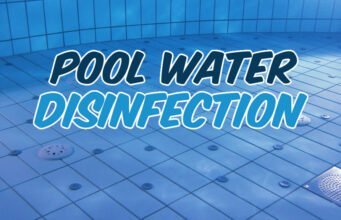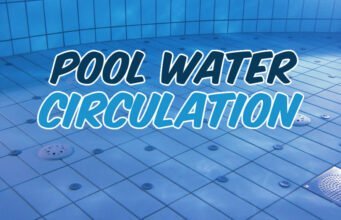The use of ultraviolet light for water disinfection is not new. In fact, in the 1990s, UV rays were already being tested as a possible sanitation system for obtaining potable water in underdeveloped countries.
Ultraviolet light for pool treatment is also very valuable as it eliminates algae and bacteria from the pool, raising the cleanliness standard of the water to points that are difficult to achieve with the manual addition of liquid or granular chlorine.
In this publication, you will understand how ultraviolet disinfection works in pool water, what these equipment are, how they are installed, what changes they cause in the water, and most importantly, how to clean the pool after installing an ultraviolet disinfection device.
The challenge of pool cleaning
As we have mentioned in our previous publications, to keep a pool crystal clear and healthy, it’s necessary to take care of three pillars: filtration, circulation, and disinfection.
Disinfection refers to the elimination of microorganisms that normally multiply in pool water. In this war against these invisible enemies, if you start losing, you may have problems such as milky or opaque water or even green water.
The challenge is to control and, as much as possible, eliminate algae, bacteria, fungi, viruses, and other germs that can cause various diseases to pool users.
To keep the water clean, it’s necessary to deal with the union of chlorine by-products with elements present in the water. If you are a pool maintenance professional or follow our publications, you may have already understood what I am referring to: chloramines.
If you don’t know what that means, access our pool dictionary and check the “Chloramine” item. In summary, it’s the compound responsible for the strong smell of chlorine in the pool.”
O poder de desinfecção da luz ultravioleta
When we talk about the sanitary use of ultraviolet light, it is necessary to say that it is divided into 3 types:
- UVA, known as black light or long wave ultraviolet;
- UVB, known as medium wave ultraviolet;
- UVC, known as germicidal light or short wave ultraviolet.
The application of UVC light in water disinfection began to be used by a scientist from California named Ashok Gadgil, who realized that by immersing a UVC emitting lamp in a container with water, that water became safe even for human consumption.
“This ultraviolet light transforms dirty water into water fit for drinking!”
The ultraviolet equipment used in the pool
If this germicide can produce water for us to drink, why not use it in the pool, right?
Nowadays, several companies have already developed equipment that allows the application of the germicidal power of type C ultraviolet to disinfect pool water.
Many people come through the comments here on the blog asking if the ultraviolet equipment from one brand or another really works. The answer is simple:
YES! THE APPLICATION OF UVC RAYS IN THE POOL WORKS EXTREMELY WELL!
Regardless of the manufacturer of the equipment, ultraviolet disinfection for pools always works.
What you need to observe is the durability of the UVC ray emitter lamp. Here you can make an analogy with the headlights of your car, or even with the lamps in your house… Do you buy lamps from your neighbor or look for established brands on the market?
Well, you need to rely on serious companies because the durability of the lamp can vary enormously and, for obvious reasons, UVC disinfection does not work if your lamp burns out!
How does UV light work in pools?
The application of UV light for pool treatment is simple. Basically, what manufacturers do is build a compartment similar to a tube with a lamp inside.
When the water passes through the equipment with the lamp turned on, pathogenic microorganisms are eliminated and the water returns to the pool free from any microbiological contamination.
IT’S ALMOST LIKE MAGIC!
UVC rays are fatal to microorganisms that cause diseases such as pneumonia, flu, cholera, and tuberculosis. Specific wavelengths of light directly destroy the DNA of these pathogens, making it impossible for these “bugs” to multiply.
Can I stop using chlorine with UV light?
A resounding “NO”, followed by an explanation…
UV disinfection equipment cleans the water that passes through the machine room, after all, that’s where it’s installed and its lamp only reaches the inside.
Therefore, even if you maintain the correct filtration time for the pool, no one guarantees that all the pool water will come into contact with the ultraviolet rays.
This type of system acts punctually inside the machine room and relies on efficient circulation to act on all the pool water. However, it does not produce a residual protection.
In other words: if you pour a glass of contaminated water into the pool, with only the UV system, you would have to wait for all the contamination to pass through the ultraviolet light before being able to use the pool. And in reality, NO ONE CAN GUARANTEE WHEN THAT WILL HAPPEN!”
So that’s why a residual protection is important!
Add chlorine into the mix and you’ll understand how things change…
If you pour the same glass of contaminated water into a pool that has about 2 ppm of free chlorine, you can continue to use the pool with peace of mind, because the residual chlorine works as an active protection by eliminating all contaminants that come into contact with the water.
What changes in a pool with ultraviolet disinfection
When you install the ultraviolet disinfection system, the first thing you should notice is the intense clarity that the water acquires.
It’s like you’re always doing a shock treatment on the pool. It looks like that idyllic water we only see in TV commercials and filtered Instagram photos. 🙂
Another thing you should notice after having ultraviolet treatment in your pool is the reduction in the amount of chlorine needed to ensure pool disinfection.
Pools with ultraviolet can save more than 90% of the volume of chlorine normally used.
Aside from being a huge cost savings, it’s a step towards peace of mind, because using less chlorine to achieve good results reduces the risk of making a mistake with measurements, and also reduces the severity of days when you simply forget to add chlorine to the pool.
How to install the UVC system for pool treatment
First and foremost, keep in mind that the installation of UVC disinfection in your pool should be done by a professional who knows the installation standards for low-voltage products available in NBR 5410.
Another important point before installing the system is to check the grounding. If there is no grounding in the network, an efficient grounding rod must be installed according to the same NBR.
The UV disinfection device should be installed in a covered and ventilated location, and its 220V power input should be connected in parallel with the motor pump power supply, meaning that it will always be activated along with the motor pump.
In addition to grounding, the installation of a residual circuit breaker with a sensitivity of 30mA is also mandatory.
The idea is that the entire volume of the pool water comes into contact with the ultraviolet light at least once a day. The more times the pool water passes through the operating equipment, the greater its disinfection power.
The ultraviolet equipment should always be installed on the pool return pipeline.
The filtration system flow rate of the pool should be less than the maximum capacity of the product to avoid creating leaks due to excess pressure or damaging the disinfection power of the equipment.
Have any doubts about using UVC for pools?
If you have any doubts about using ultraviolet light for pool treatment, leave us a comment below. The community is always ready to chat and debate about all kinds of pool-related topics.
It’s like this: despite the busy life at Agência Sete Clave and my other projects, I keep trying to answer the comments here.
If you liked it and want to thank me for my work, we have a crowdfunding campaign starting to take off. You can participate, but only if you want to, okay?
Big hug and see you next time!










